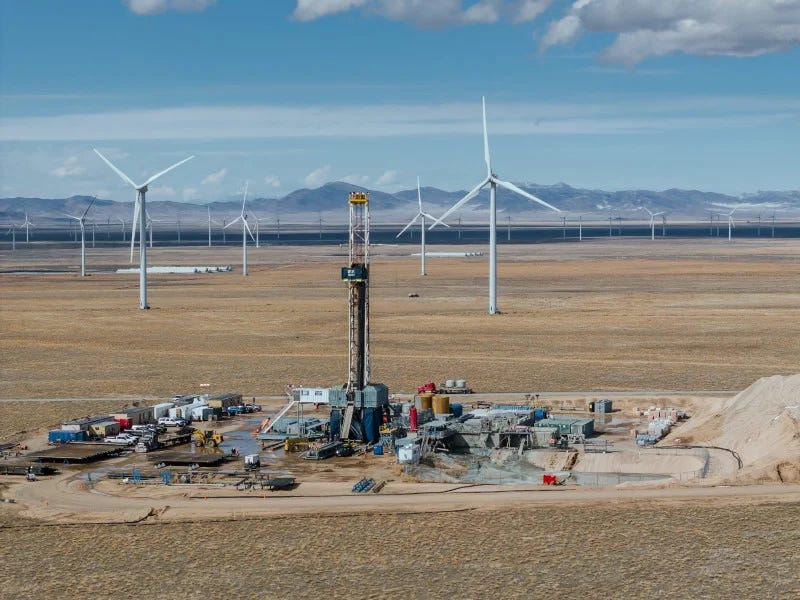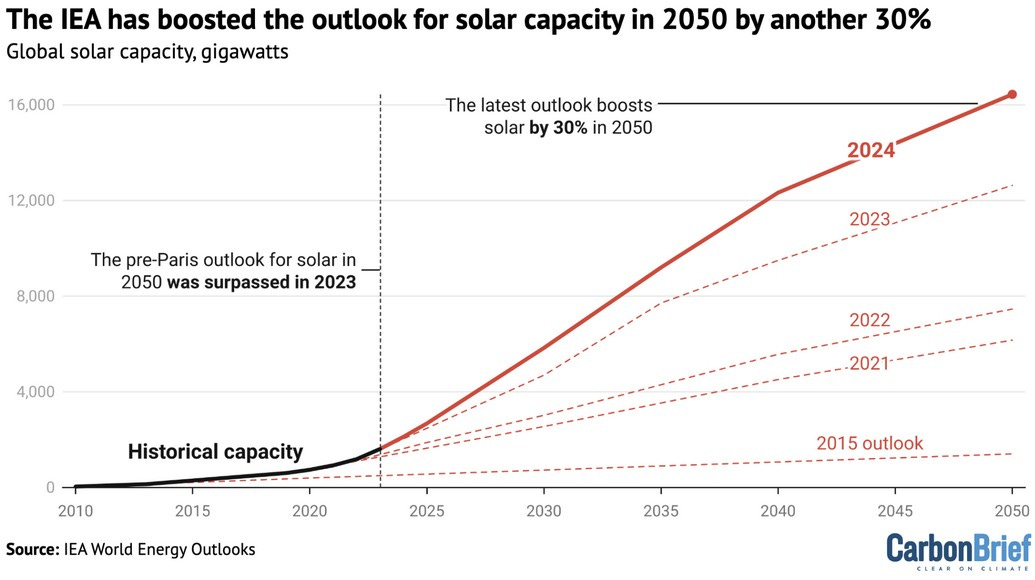The Weekly Anthropocene, October 23 2024
Solar to quadruple by 2030, Bangladeshi mangrove tigers, rural electrification across Burundi, a 110-year-old thylacine head, Star Trek tree frogs, the new Chumash Heritage marine sanctuary, and more!
The Big Picture
Two big new reports on the state of clean energy and the global fight against climate change dropped recently: the International Energy Agency’s annual World Energy Outlook for 2024 and a lesser-known consultancy’s report that has broadly similar findings. They have some very, very, very good news. Key takeaways include:
Solar power continues to grow insanely rapidly worldwide, and will likely quadruple by 2030.
Solar power will likely become the world’s biggest source of electricity by 2033.
The IEA now expects 16,000 GW (16,000,000 MW) of solar power capacity on Earth by 2050, 11 times more than what they expected for 2050 as of 2015.
As of 2023, we’ve already built more solar than what the 2015-era IEA expected would be built by 2050. Think about that for a moment!
Battery storage is also growing rapidly, and its forecasts also keep being revised up.
EVs are being adopted faster than expected, and are set to displace six million barrels of oil per day by 2030.
The IEA expects the much-hyped AI-driven data centers boom to drive only 3% of electricity demand growth to 2030.
Thanks to this gigantic cleantech boom, global carbon dioxide emissions are likely peaking right now. As in, 2024 (per the consultancy) or 2025 (per the IEA) may be the all-time high-water mark for how much CO2 humanity pumps into the atmosphere each year.
On a personal note, as someone who’s been obsessively following climate, cleantech, and emissions news since their age was in single digits…WOW! Look how far we’ve come! We are making progress, folks! We can win this thing. Now we just need to accelerate on the right track.
Bangladesh
Bangladesh reports that per a recent camera trap survey, the Bengal tiger population in the great salt mangrove wetlands of the Sundarbans is steadily rising, from an estimated 106 individuals in 2015 to at least 125 individuals today. Anti-poaching patrols have increased in recent years, deer populations are rising, and new fences have been installed to reduce endemic human-tiger conflict.
The Sundarbans is a truly fascinating area; in addition to its tigers among the mangroves (who are unusually ferocious, possibly due to drinking salt water), it’s known for its crocodiles, pirates, and devout following of the forest goddess Bonobibi. Sy Montgomery’s classic Spell of the Tiger is a great book about it. Fascinating world!
Morocco
Emerging cleantech star Morocco has announced plans to build 1.4 gigawatts (1,400 megawatts) of new wind and solar capacity in the recently annexed Western Sahara region by 2027. (Here’s The Weekly Anthropocene’s in-depth takeaway from a 2023 visit to this fascinating country). Solar in the Sahara: lots of room to grow! Great work.
Australia
In a potentially huge milestone for de-extinction, an unprecedentedly high quality nearly-complete genome of the Tasmanian tiger (Thylacinus cynocephalus, aka the marsupial wolf or thylacine, a large marsupial carnivore driven to extinction in 1936) has been pieced back together from a 110-year-old pickled thylacine head that was found abandoned in a bucket in a Melbourne museum cupboard. U.S. biotech startup Colossal plans to gene-edit the new thylacine DNA and RNA into the stem cells of related marsupials, and hopes that the first animal with reborn thylacine genes could be born in three to five years. May this bold endeavor succeed! Amazing work.
Burundi
The Biden-Harris Administration has long worked to increase American investment in fast-growing Africa. Now, in an inconspicuous but life-changing milestone, the United States will be funding mass rural electrification for the impoverished nation of Burundi through the U.S. Trade and Development Agency (TDA) and Development Finance Corporation (DFC), supporting local utility startup Weza Power in a plan to expand the rural grid. Burundi built its first solar farm recently and is planning many more; the modern economics of rural electricity make it near-certain that solar will provide the lion’s share of this new power surge.
Burundi is one of the poorest countries in the world, and currently only about 12% of the country (less than 2% in rural areas!) has access to electricity. This project is set to raise that from 2% and 12% to over 70% in rural areas and 76% nationally by 2030, giving over 9 million Burundians access to electricity for the first time. Lives will be transformed across this nation, thanks to U.S. investment and global solar progress.
Absolutely spectacular work!
“These agreements, and the cooperative efforts to provide electricity to all Burundians, represents another U.S. investment in the future of this country. With an expanded national grid, and increased power supplies, electricity will reach the rural communities. Every single Burundian will someday benefit from the impact of these projects.”
-U.S. Ambassador to Burundi Lisa Peterson.
Madagascar
Seven new species of genus Boophis tree frogs discovered in Madagascar’s rainforests have been named after Star Trek captains Kirk, Picard, Sisko, Janeway, Archer, Burnham, and Pike, in honor of their calls’ similarity to the classic “boatswain whistle” and “tricorder” sound effects. Awesome!

A baby greater bamboo lemur (Prolemur simus) was born at a wildlife park in Britain. The greater bamboo lemur is critically endangered in its Madagascar rainforest homeland, and there are only 36 individuals in captivity worldwide. Notably, this is the same lemur species that The Weekly Anthropocene spent several months studying and working to protect near Kianjavato, Madagascar, in summer 2019. Great news!
United States
On October 11, 2024, President Biden formally announced the designation of the Chumash Heritage National Marine Sanctuary, following years of consultation with local stakeholders. America’s 17th and newest national marine sanctuary protects 4,543 square miles of ocean along 116 miles of California coastline, bringing the total area of U.S. land and waters conserved under the Biden-Harris Administration to over 45 million acres. The new sanctuary is home to a rich biodiversity of marine mammals, seabirds, kelp forests, and the abundant species community found atop a local underwater seamount, as well as over 200 documented shipwrecks.
Two unusual aspects of this new marine protected area are particularly interesting. This is the first-ever U.S. federal protected area to be established and managed in partnership with local indigenous peoples, with a unique new management framework including the voices of the Santa Ynez Band of Chumash Indians and other local groups.
This sanctuary designation is also part of a long-term plan to coexist with future offshore wind farms nearby. An area of ocean just north of the current Chumash Heritage boundaries was not included in the sanctuary to allow for potential future construction of planned transmission lines and floating substations to connect the Morro Bay Wind Energy Area to the mainland grid, and NOAA will consider expanding the sanctuary to cover the area once construction is complete.
America’s latest protected area is a fascinating gem of the Anthropocene!
“This sanctuary designation marks a hard-fought victory for the Chumash people, our conservation priorities, and the responsible development of offshore wind as California strives to meet its ambitious clean energy goals.”
- Alex Padilla, U.S. Senator from California.
The Biden-Harris Administration announced nearly $2 billion in a new round of Grid Resilience and Innovation Partnerships (GRIP) grants, vital funding to protect, expand, and modernize America’s electric grid! These new projects are set to spark an additional $4.2 billion in additional public and private investment, as well as enabling 7.5 GW of much-needed new transmission capacity. Much of the new funding will flow to storm-damaged states in the Southeast. Great work!
Biotech startup Moolec has received USDA planting clearance for its peas genetically modified to produce beef proteins. An exciting new step forward for low-emission, cruelty-free plant-based meats! This writer can’t wait to try some.
Total U.S. power plant emissions in 2023 were 7.2% lower than in 2022 and 33.8% lower than in 2011, as renewables surge and coal plants retire!
On October 16, 2024, the Department of Energy’s Loan Programs Office (leading disbursers of the Biden-Harris Administration’s IRA cleantech funds!) announced a $3 billion in U.S. investment in two groundbreaking sustainable aviation fuels (SAF) projects1. Gevo Net-Zero is planning to build a new corn starch-to-jet fuel refinery in South Dakota, while Montana Renewables will expand their vegetable oils-to-fuel facility in Montana. SAF is a very early-stage sector, with jet fuel being among the most difficult-to-decarbonize parts of the global economy, so this is a big first step!
Amazon and Google have joined Microsoft in signing deals to purchase nuclear power for their data centers, potentially boosting the previously slow-moving field of small modular reactors. Still a small sideshow, but more clean electrons are good!
The U.S. Supreme Court has refused to block the Biden-Harris EPA’s plan to reduce emissions from fossil fuel power plants, denying an appeal from Republican states. Good news! Now, let’s vote to keep our progress towards cleaner air.

The Biden-Harris Administration’s Bureau of Land Management has approved pioneering enhanced geothermal startup Fervo Energy’s Cape Geothermal Power Project in Beaver County, Utah, with the potential to generate up to 2 GW (2,000 MW). The BLM also moved to streamline permitting for enhanced geothermal projects on federal lands with a NEPA categorical exclusion, a much-needed tool to speed up decarbonization. The Great American Geothermal Boom is on the way!
Some conceptual background on where this fits into the global cleantech transition: making fuel from plants isn’t really a good idea for cars, since batteries can do the job much better. But batteries get really heavy as they get bigger, and so far that’s remained a barrier to making EV airplanes. Burning plant-based fuels still emits carbon dioxide, but those carbon molecules were taken out of the air by the plants sometime in the last couple years, not released from millions of years of entombment as fossil fuels, so using SAF is recirculating carbon that was already in the atmosphere and not adding more from underground. Here’s hoping these projects work out!















1. I wanna see a de-extinct thylacine when they exist!!
2. Probability that team Ecology Puritans will condemn a de-extincted thylacine being re-introduced into its native home as an "invasive" approaches 100%
I was needing some good news. Thank you!